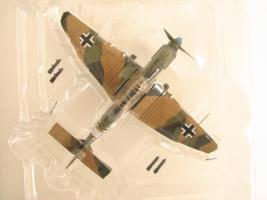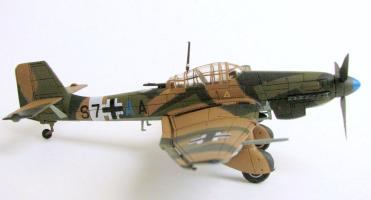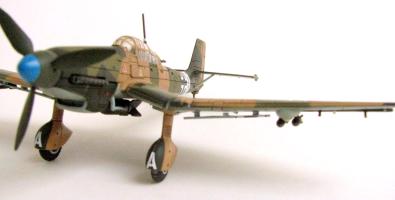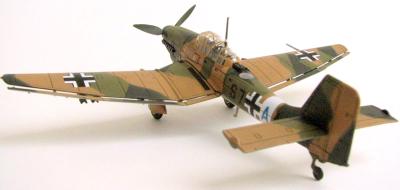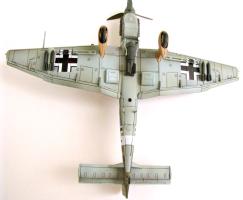Hobby Master Archive
Air Power Propellers 1/72
Ju-87
Ju-87-D3, StG. 3 Geschwaderkommodore Walter Sigel, Libya, 1942
Gruppenkommandeur Hauptmann Walter Sigel 116th recipient of the Knight’s Cross July 7, 1940 and awarded Oak Leaves on Sept 2 1942.
In the small Polish city of Wielun, September 1 1939, 4:50 - 5:30 am German bombers of I./KG76 (4. Luftflotte) dropped their bombs and then proceeded to machine gun the fleeing citizens. A total of 120 aircraft took part in the attack that came in three waves. It is estimated over 70 tons of bombs were dropped killing more than 1,200 civilians out of the total population of 16,000. Thousands more were injured and nearly 70% of the city structures lay in ruin. Some say the Luftwaffe operated using professional military code of conduct dating back to WWI but many Polish stories contradict this. The closest Polish military forces were situated outside the city to the southwest, not in the city and this is what makes this conflict so controversial. The Luftwaffe bombers were commanded by the then Oberstleutnant Walter Sigel. Stories of this attack would follow Sigel for the rest of his life.
After the “Battle of Britain” Sigel’s Gruppe was transferred to Sicily and from there to North Africa where from February 1941 - April 1943 it flew in support of German forces. After Oberstleutnant Karl Christ (Kommodore: April 1st 1941 - February 1942) relinquished command of StG3 to Oberstleutnant Walter Sigel (Kommodore March 1st 1942 - April 1st 1943), St.G. 3 became a combination of several Gruppen that had used unit codes - 2F, S1, A5 and T6 but became one – S7. February 1941 towards April 1943 it flew in support of the German forces in Africa. Early in April 1944 the Geschwader (wing) was transferred to the Eastern Front and stayed in the northern and central sectors until the wars end. Walter Sigel didn’t go to the Eastern Front instead he transferred to Norway to serve as Fliegerfuhrer (theater commander). On May 8 1944 Sigel was on an inspection flight over a fjord near Trondheim when his light Storch plane struck a power line killing him. At the time of his death it is estimated that Sigel had flown over 300 sorties. Killer or great pilot and leader, Sigel will be the subject of history buffs for many years to come.
| Added to archive | 2015-11-19 |
| Last modified | 2015-11-19 |
